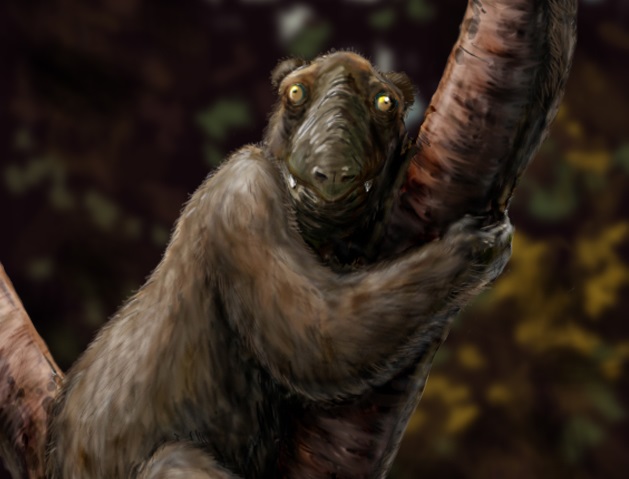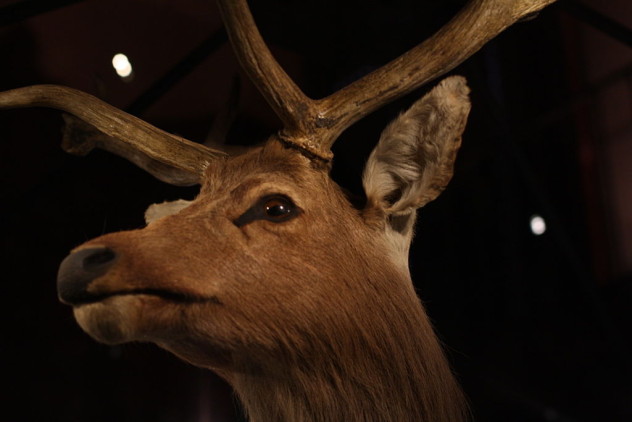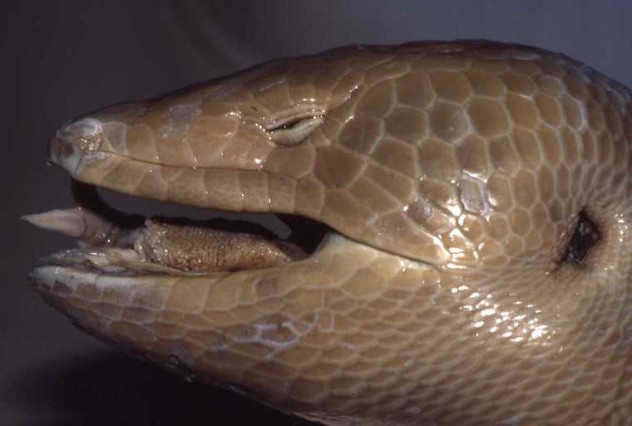Mother Nature and humankind have obliterated countless species. Survival of the fittest has led to the extinction of some rather astounding creatures. None can last forever, but it's a shame we'll never see some of the most magnificently unique in person.
大自然母亲以及人类活动已使得很多物种灭绝。"适者生存"淘汰了相当一些令人惊叹的生物。没有东西能长存。可惜的是我们不能亲眼见证这些独特的神奇动物了。
10.巨狐猴

Though they weren't named until 1894, koala lemurs existed long ago during the late Pliocene to the Holocene period. Scientists believed they might be related to modern lemurs. However, fossil testing revealed no relation between the small Lepilemur and extinct Megaladapis edwarsi, which had a skull the size of a gorilla's.
直到1894年被正式命名时,巨狐猴早已度过它们在地球的生活,现已灭绝。它们存活的时间最早可追溯到上新世晚期到全新世。科学家们认为现代狐猴可能为巨狐猴后代。然而,化石检测结果显示小鼬狐猴与已灭绝的巨狐猴并无任何关系。巨狐猴的头骨大小与大猩猩头骨大小相同。
Megaladapis edwarsi grew to 1.5 meters long (5 ft), and weighed up to approximately 75 kilograms (165 lb), possibly more. Its arms were longer than its legs, and they were made for climbing trees. It was too large to leap, and likely spent most of its life on the ground. Megaladapis edwarsi could have traveled on all fours much like an orangutan.Humans arrived in Madagascar about 2,000 years ago. Since then, 17 known species of lemur have gone extinct. Megaladapis edwarsi is among the most notable because of its size. Being so large made it slow and easy to hunt. Radiocarbon dating shows these koala lemurs went extinct following European settlement on Madagascar; the last one died about 500 years ago.
巨狐猴身长可至1.5米,体重可达约75公斤或者更重。因为要爬树,所以它们的手臂生得比腿还要长。由于体型较大,巨狐猴无法自由地在树间跳跃,因此它们极有可能只是生活在地面上。就像猩猩一样,巨狐猴可能是四足并用地走路。大约2千年前,人类的足迹渐现于马达加斯加岛。自那时起,17种已知的狐猴种类开始走向灭绝。由于体型原因,巨狐猴是这些灭绝的狐猴中最引人注意的。它们相对于其他狐猴种类较大的体型使它们行动缓慢,因而更容易被捕猎。放射性碳年代测定法显示,自欧洲殖民者侵入,巨狐猴就开始灭绝。最后一只巨狐猴死于大约500年前。
9.Giant Australian Python--Wonambi Naracoortensis
9.澳大利亚巨蟒——沃那比蛇

Wonambi naracoortensis lived during the Pliocene epoch in Australia. "Wonambi" is the Aboriginal word for "rainbow serpent." This enormous snake lacked the jaw flexibility of most evolved snakes. The most advanced snakes can disarticulate their jaws, while lizards have zero jaw flexibility. This means the wonambi was, in evolutionary terms, at a phase between the lizard and the modern snake. The wonambi skull resembles fossils of the Cretaceous period more closely than the skull of any modern snake.
沃那比蛇生活在上新世时期的澳大利亚。"Wonambi"在当地土著语中是"彩虹之蛇"的意思。与大多数进化到现代的蛇类相比,澳大利亚巨蟒并不具备灵活的下颌。最高级的蛇类能够完全放松下颌,而蜥蜴却恰恰与此相反。这就意味着,从进化学看,沃那比蛇生存于蜥蜴跟现代蛇类的中间期。与现代蛇类头骨相比,沃那比蛇的头骨大小与白垩纪时期的蛇类头骨大小更为相似。
This non-venomous wonambi grew more than 4.5 meters (15 ft) long. It had recurved teeth without fangs, and constricted its prey. Most scientific estimates peg extinction at 40,000 years ago, though it's possible they could have survived to as recently as 7,000 years ago. Similarities to other extinct snakes in South America and Africa suggest a common ancestor from the days of Pangaea. Something tells me none of them were ever house pet material.
沃那比蛇是一种无毒蛇,它们身长可超过4.5米。沃那比蛇的牙齿内弯而无尖,用以困住猎物。很多科学家猜测沃那比蛇灭绝于4万年前,然而另一种猜测则宣称沃那比蛇可能灭绝于约7千年前。南美与非洲大陆上已灭绝蛇类的相似处说明它们可能拥有生活在泛大陆时期的共同祖先。而这些蛇类没有一种适合当做宠物饲养。
8.大海雀

The great auk was a whimsical black and white flightless bird. Nicknamed "the original penguin," it stood about 1 meter (3 ft) tall and had tiny 15-centimeter (6 in) wings. Hundreds of thousands—possibly millions—thrived in North Atlantic ocean waters for centuries. They lived near places such as Scotland, Norway, Canada, the US, and France, but only ventured onto land to breed.
大海雀是一种黑白毛色的古怪的鸟——它们不会飞。另称"原始企鹅"的大海雀身高1米,它们的翅膀只有15厘米长。几个世纪以来,上万,不,或许有好几百万的大海雀生活在北大西洋沿岸。它们生活的水域靠近苏格兰、挪威、加拿大、美国和法国,但只有在繁衍的季节它们才会飞到内陆。
Great auks became highly valued in the 1700s. They'd been hunted for thousands of years, but during this period the killing spiraled out of control. Valuable feathers, pelts, meat, oil, and 13-centimeter (5 in) eggs tempted hunters and collectors. Great auks became endangered, and their rarity only heightened demand. On July 3, 1844, Sigurour Isleifsson and two other men visited the last breeding colony on Iceland's Eldey Island. A mother was incubating her egg with her mate nearby. Two of the men strangled the live birds, and the third crushed the egg with his boot. The destructive trio had been hired by a merchant to hunt the birds. The great auks they asphyxiated were the last mating pair ever seen. The last known live great auk was spotted in 1852 at The Grand Banks of Newfoundland, Canada.
在18世纪,大海雀被高价悬赏。尽管之前也有人捕杀大海雀,但在这个时期,大海雀的捕杀数量和速度已经开始不受控制。大海雀的羽毛、表皮、肉、脂肪以及它们13厘米长的蛋无不吸引着收藏家们和捕猎者。大海雀濒临灭绝,但它们的罕有却使得对它们的市场需求进一步上升。1844年7月3日,席谷拉·艾斯雷森(Sigurour Isleifsson)和另外两人探访了大海雀在冰岛埃尔德岛的栖息地,这也是世界上最后一个大海雀的栖息地。雌鸟正在雄鸟的看护下孵化鸟蛋。两人将活鸟生生扼死,剩下一人则将孵化中的鸟蛋给踩碎。他们正是受雇于某商人来捕杀大海雀的。他们所捕杀的是世上已知的最后一对成双的大海雀。有人最后一次目击到活着的大海雀是在1852年,现于加拿大纽芬兰岛的大浅滩。
7.熊氏鹿

Plentiful numbers of Schomburgk's deer once roamed Thailand. The animal was described and named in 1863, after the British consul of Bangkok at the time, Sir Robert H. Schomburgk. It's estimated to have gone extinct in the 1930s. Some believe the deer still lives, but scientific observations have not validated this assertion.
曾有大量的熊氏鹿活跃在泰国。熊氏鹿在1863年时被描述入册,并以当时曼谷的英国领事罗伯特·朔姆布尔克阁下(Robert H. Schomburgk)命名。人们猜测熊氏鹿可能是在1930年间灭绝的。也有一些人相信熊氏鹿依然存活,但并没有任何科学证据验证这一说明。
Schomburgk's deer antlers were believed to contain powers of magic and healing. The species became widely sought after by hunters, and fell victim to the traditional medicine trade. During floods, they gathered at high points; this made them especially easy to kill. Boaters targeted them when they had nowhere to run. Human settlement and commercial agriculture destroyed much of their habitat.The last wild Schomburgk's deer was killed in 1932. The last domesticated one died in 1938. Interestingly, in 1991, UN agronomist Laurent Chazee photographed a pair of antlers at a traditional medicine shop in Laos. The antlers were later identified as Schomburgk's deer antlers.
人们认为熊氏鹿的鹿角拥有魔法以及治愈的能力。因此,熊氏鹿成为了猎人们追逐的目标,也是传统医药交易的热门商品。洪水期间,熊氏鹿会躲避到高处,这使得它们更容易受到捕杀。当它们在洪水茫茫中无处可逃时,船工们轻而易举地就能捕到它们。人类定居和商业性农业生产破坏了大多数熊氏鹿的栖息地。最后一只野生熊氏鹿在1932年时被捕杀。而最后一只被驯养的熊氏鹿则死于1938年。有趣的是,在1991年,联合国农学家劳伦特·查斯(Laurent Chazee)拍摄了一家老挝的中药房摆放的鹿角。这双鹿角之后被确认为熊氏鹿的鹿角。
6.Jamaican Giant Galliwasp
6.牙买加巨草蜥

The last recorded sighting of a Jamaican giant galliwasp occurred in 1840. Also known as a sinking galliwasp, it grew to around 60 centimters (2 ft) long and terrified locals. Its extinction was likely due to the introduction of predators—such as the mongoose—in Jamaica. Habitat destruction by humans may have also played a part in their elimination.
登记在册,人们最后一次见到牙买加巨蜥时是在1840年。它们也被称作"下沉的巨蜥",牙买加巨草蜥可长至60厘米,而这造成了当地人的恐惧。牙买加巨草蜥的灭绝可能是由于牙买加境内捕食者的引入,例如猫鼬。人类对它们栖息地的破坏也可能是其灭绝的原因。
Galliwasps are a subject of fables. Jamaican natives believe the animal is venomous. After a bite, legend explains, the galliwasp and the person who was bitten will head for water. The first to reach it will live. The other will die. This is no longer a worry pertaining specifically to the Jamaican giant galliwasp, though. This species is believed to have gone extinct more than a century ago. Very little is known about this swamp-dwelling lizard, though we can tell it ate fish and fruit. Few specimens exist today. Bleached and preserved Jamaican giant galliwasps are kept at a small number of museums.
牙买加巨草蜥一直是寓言的主题。当地人认为牙买加巨草蜥是剧毒的。寓言说,被牙买加巨草蜥咬后,被咬的人与咬人的蜥蜴都会朝水中走去。前者到达水源后会死,而后者则会活下来。然而现在人们已不对牙买加巨草蜥感到恐惧。牙买加巨草蜥可能在一个世纪前就已灭绝。人们对这种居于沼泽的蜥蜴知之甚少,但可以确定的是牙买加巨草蜥吃的是鱼类和水果。很少牙买加巨草蜥的标本能留存今日。经过漂白等程序保存下来的牙买加巨草蜥标本只有少数几个博物馆保有。

















